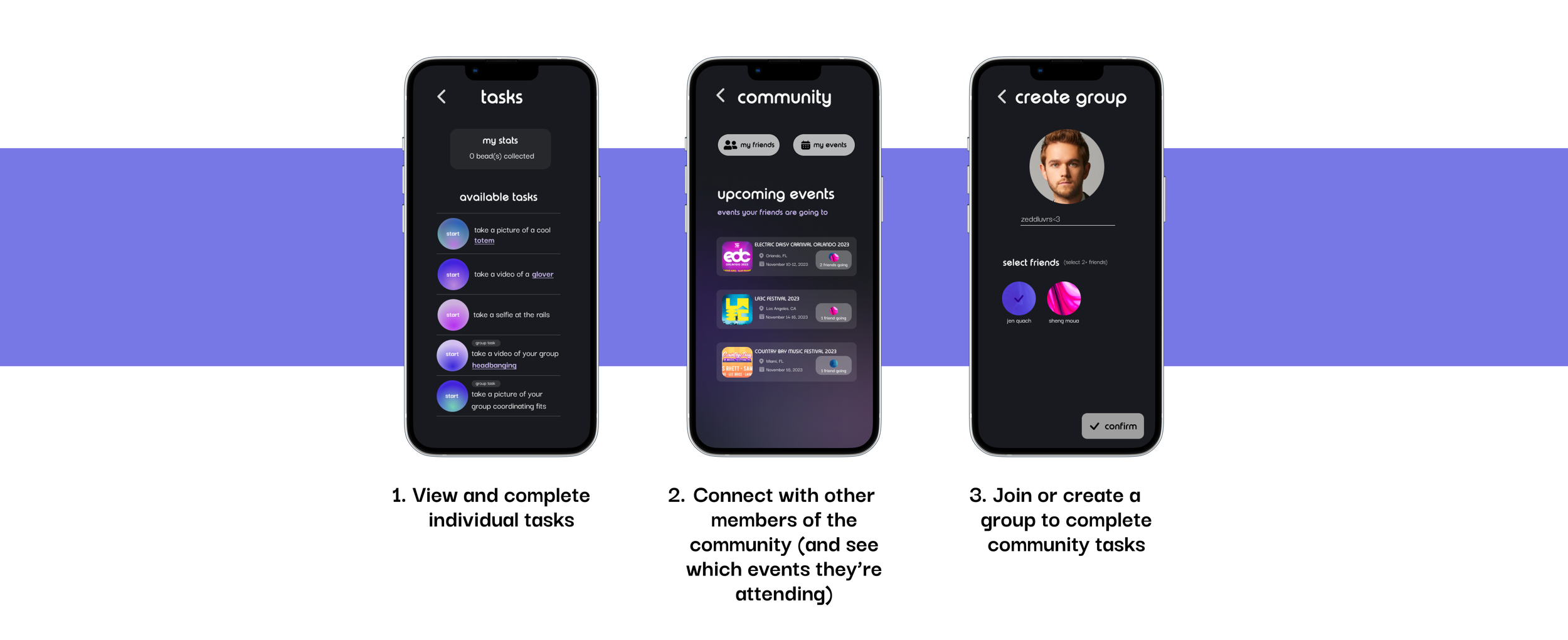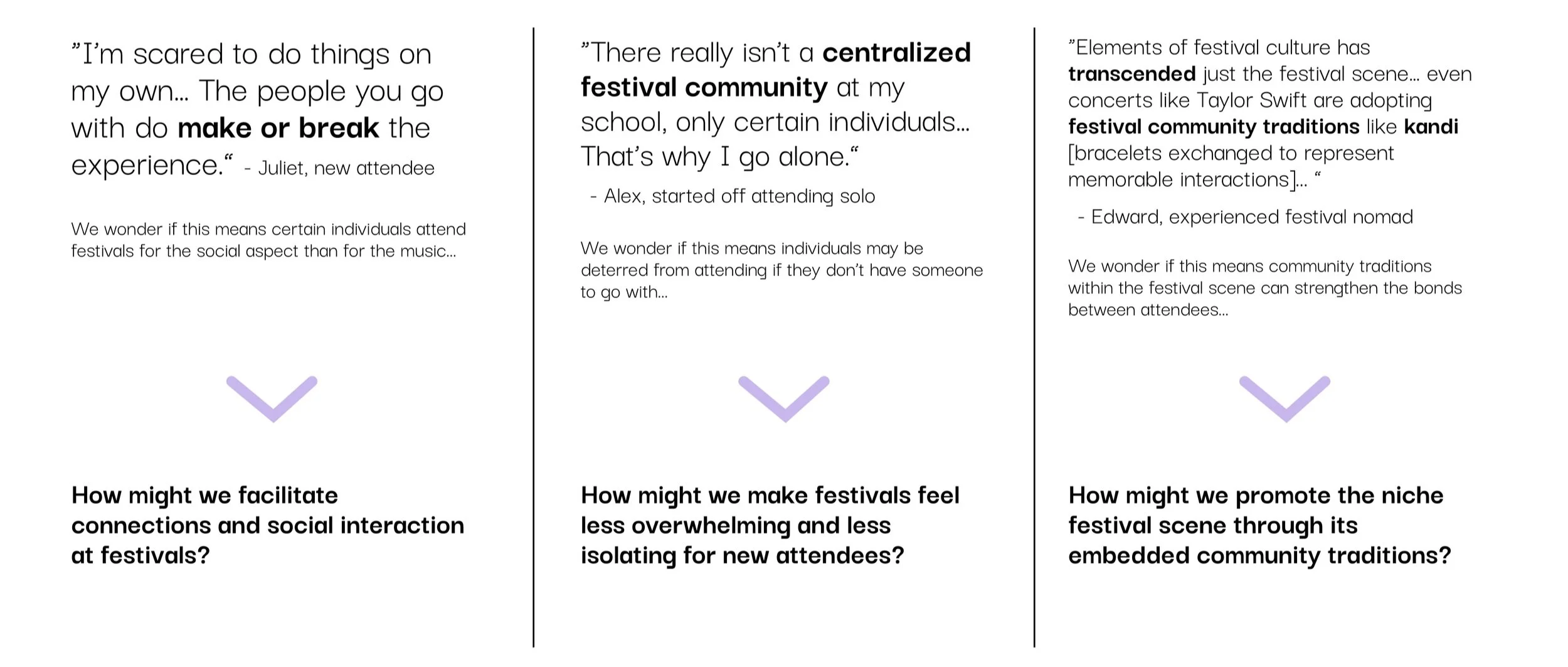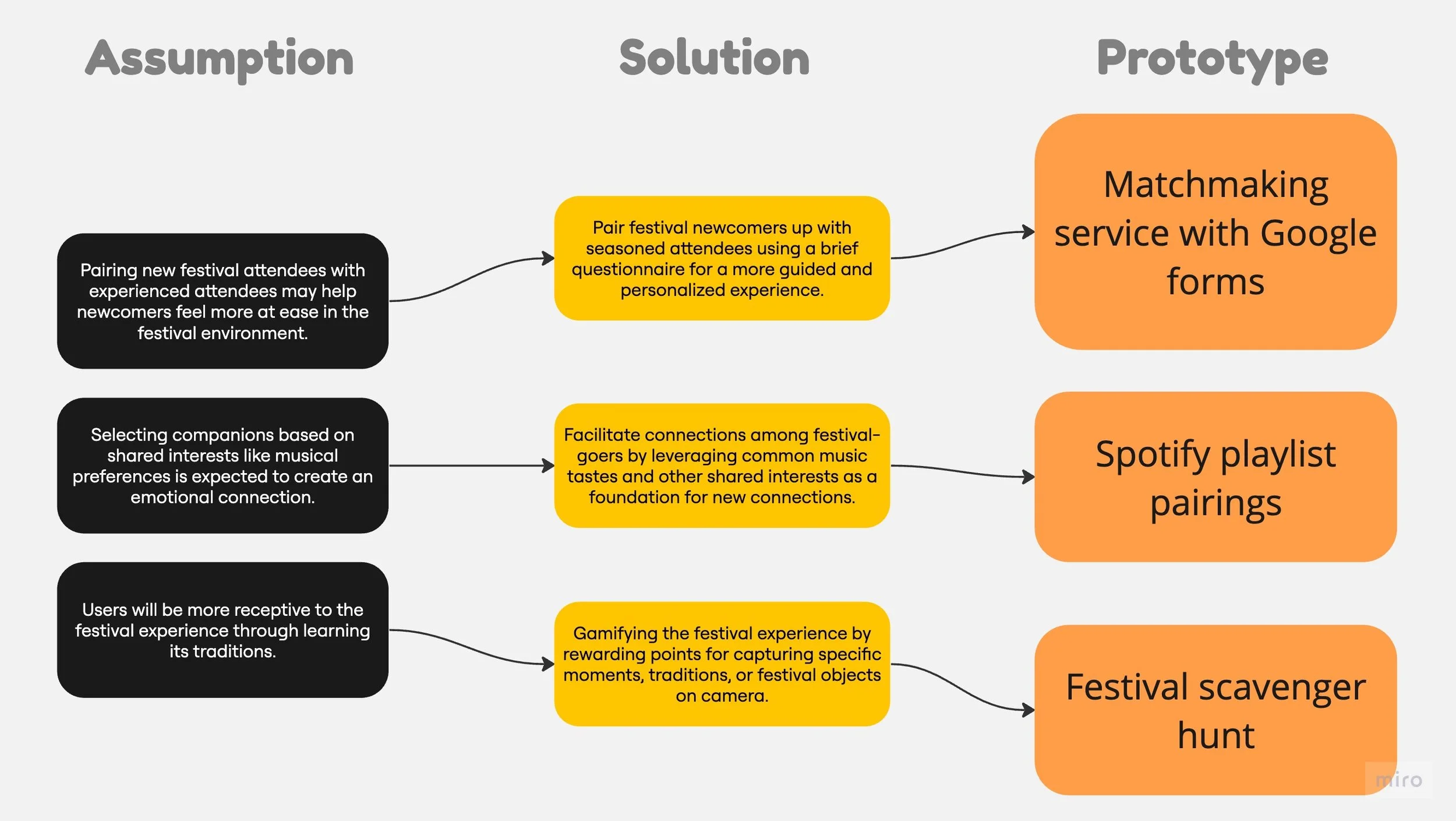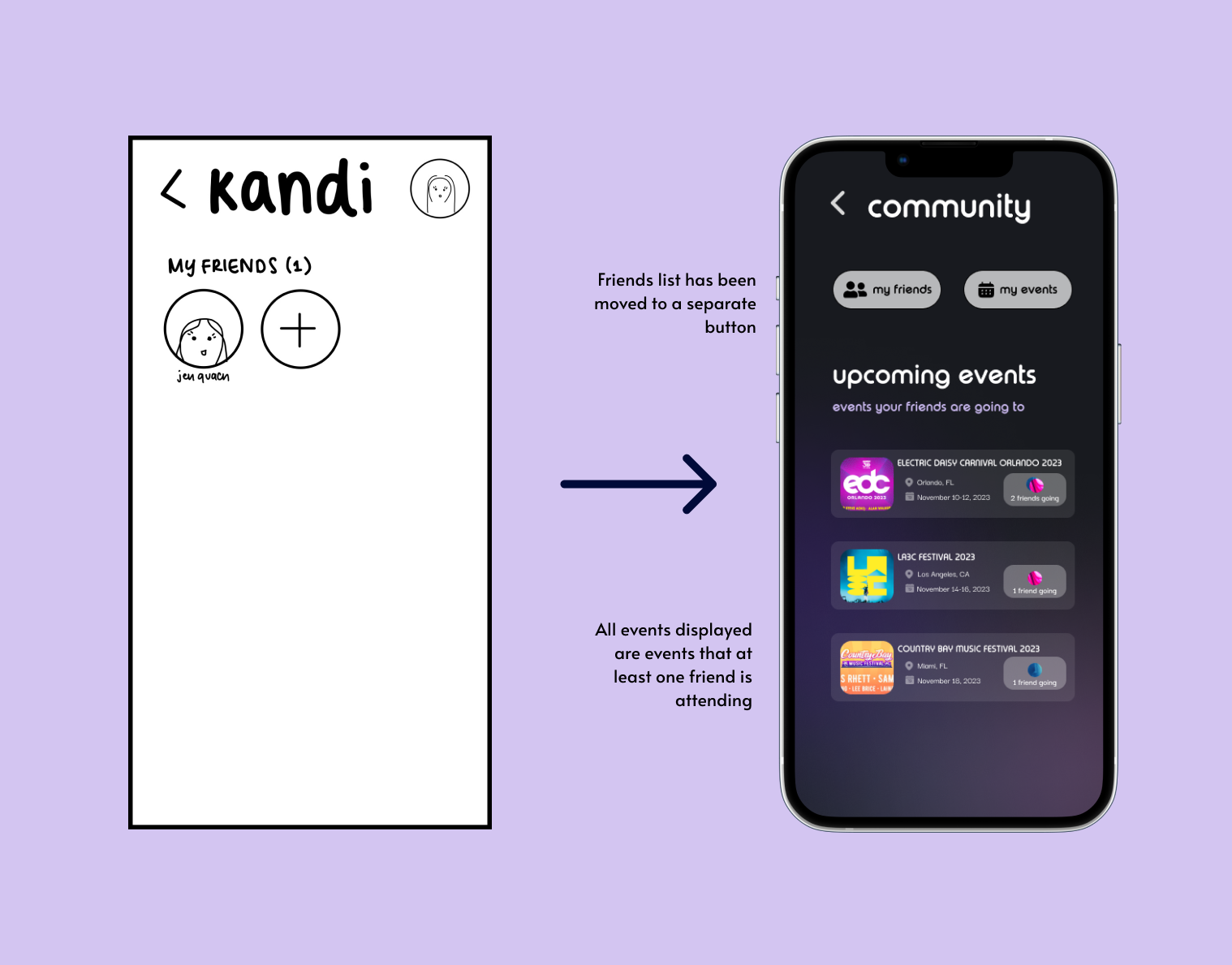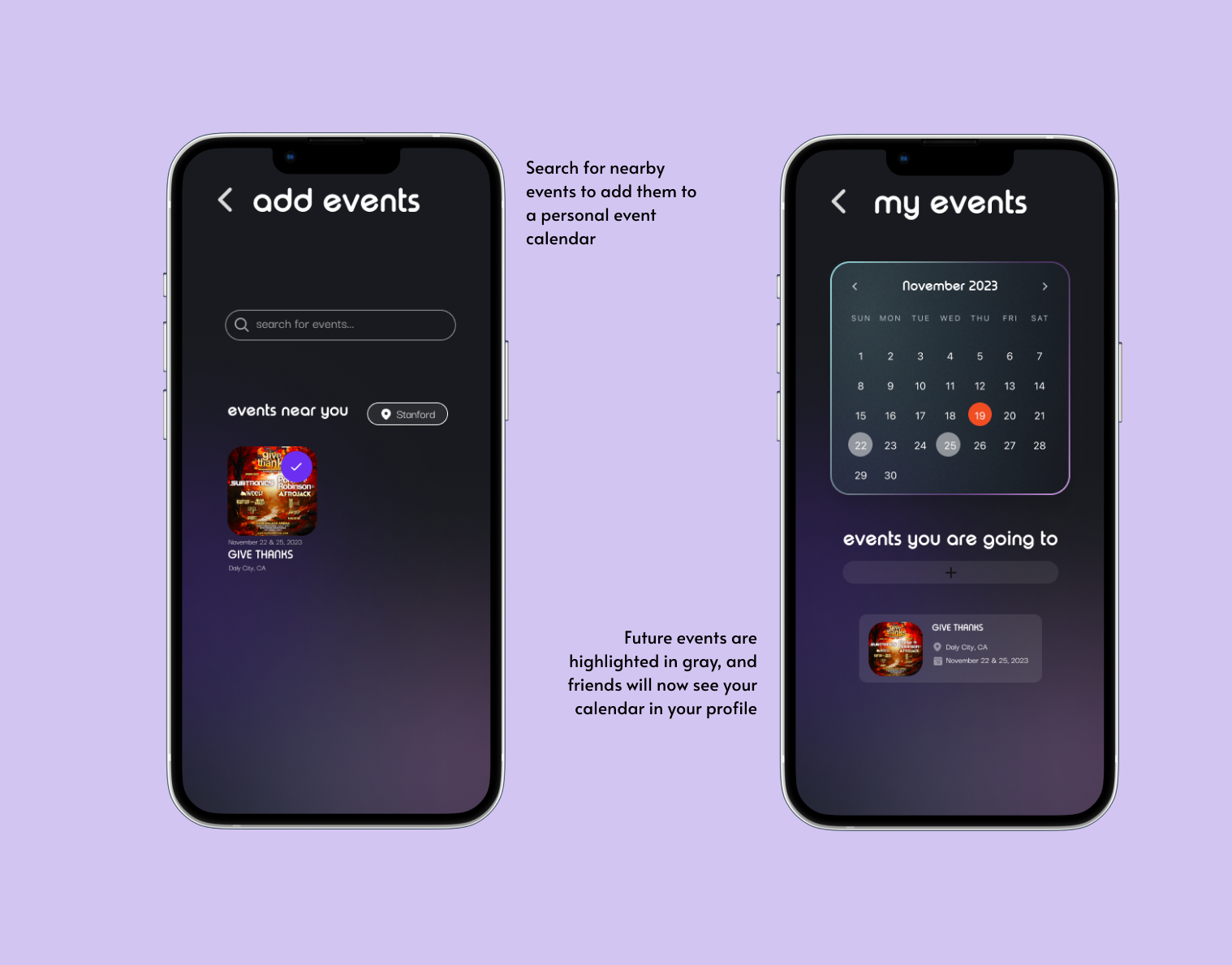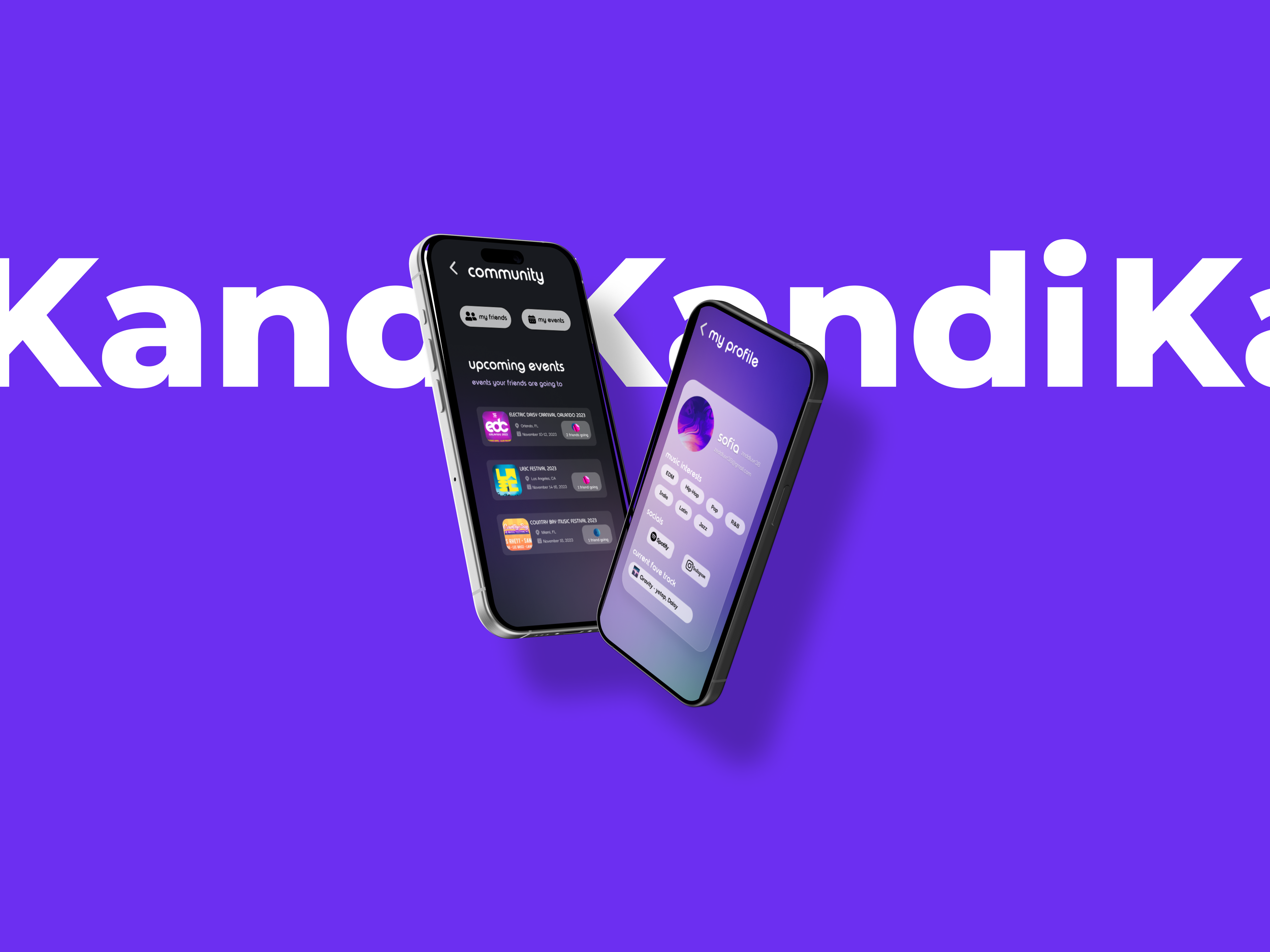
Overview
You’re at your first music festival, surrounded by music you love but a crowd you don’t know. Let’s change that.
In creating a social platform that gamifies the festival scene to ease new users into the community, we hope for Kandi to close the gap in experience amongst attendees and allow all users to experience the vibrant energy that music festival bonds foster. Users will create groups and add friends, view each other’s event calendars, and capture festive memories through a series of achievements.
Role
Product Manager, Designer, Full-Stack Developer
Tools
Figma, Miro, React Native, Photoshop, After Effects
Team
Sofia Kim (Designer), Sheng Moua (Developer)
Timeline
10 weeks
My Impact
Conducted user and market research, leading all user interviews and usability testing. Managed and established roadmap for a cross-functional team, built wireframes, interactive low to high fidelity prototypes, UX flows, worked on front-end development, and gave pitch presentation at Stanford HCI’s Design Expo to key stakeholders, earning 1st place out of 40+ teams in “Best Visual Design.”
Problem
New attendees to music festivals often face a sense of isolation and overwhelm due to foreign traditions and a lack of prior connections or knowledge to the scene. This contributes to a shared struggle to navigate and integrate into the community.
Challenge
How might we create a more welcoming experience for new music festival attendees by promoting its embedded community traditions?
Solution
Gamify the festival experience to ease new users into the community, with achievements gained from capturing festive memories and making new connections.
01 Problem Discovery
Duration: 1 week
Tasks: 5 interviews, 3 empathy maps, 3 POV’s, 30 HMW’s
Context
We delved into the vibrant realm of music festivals, a domain space representing a dynamic fusion of fashion, art, and cultural traditions.
Promoting itself as a space where community bonds flourish and a spirit of mutual respect is celebrated, our exploration was driven by the desire to truly understand how big the impact of community is in enhancing the festival experience.
Needfinding
I led our team through an extensive user research process that started with a first round of needfinding interviews that aimed to include a wide range of experiences (never attended to festival nomads), age, careers, and musical interests. We visualized our observations and user pain points in the form of empathy maps of three interviewees with highly contrasting characteristics.
Define
We generated 3 POV’s, 10 HMW’s, and separated all 30 into separate user pain points using heat map voting. We narrowed down our user challenges to the following 3 HMW’s to prepare for ideation:
02 Ideation
Duration: 2 weeks
Tasks: 3 experience prototypes, solution prioritization, concept video
Brainstorming
With divergent thinking, our goal is to explore as many solutions as possible from our 3 HMW’s, ranging from pragmatic answers to dark horse ideas. To ensure that our solutions are user-centric, we came together to create 3 experience prototypes to test our assumptions of our users, as shown below.
Takeaways
Our project name, Kandi, was inspired by the colorful beaded bracelets in festival culture that symbolize mutual respect and acceptance.
These kandi bracelets are traded among the crowd to represent memorable interactions with new connections. As our assumptions all stood, we can now proceed with ideating our final solution with this concept in mind.
-
A quick survey to pair attendees up with each other showed that users want to go with people they trust and know. The matchmaking service was well received due to its swift and easy process.
-
Shared musical interests seemed to be the easiest way to facilitate social connections, although the Spotify prototype couldn’t determine in-person compatibility.
-
The meaning of traditions are important to realizing community values within the scene. All users were receptive to learning more, and the scavenger hunt prototype was well received.
Finalized problem & solution
Problem:
New festival attendees find it difficult to get into the scene because of the complex and foreign festival culture.
Solution:
A social platform that integrates new users into the scene by gamifying the festival experience, earning achievements for making new connections and learning traditions.
Concept video
Our concept video was story boarded with the intent of showing a use case for a new user, which I edited all on After Effects. Check it out with the link below!
03 Prototype & Test
Duration: 5 weeks
Tasks: low-fi to hi-fi prototypes, usability testing, heuristic evaluations, app development
Task flows for our MVP
Our team prioritized 3 tasks for the user to test when building our prototype with initial concept sketches (not pictured). We expanded on the tasks and added more features as we went along. They are listed as follows in the order of difficulty for the user:
Simple task: View and complete individual tasks.
Moderate task: Add and connect with other members of the community.
Complex task: Join or create a group to complete community tasks.
Usability goals
Our usability goals for each prototype were user satisfaction, intuitive navigation, and functionality.
We measured each goal by asking the user for ratings, measuring number of mis-clicks, and percentage of tasks completed successfully. Three task flows from our lo-fi prototype are pictured below.
Low-fi Prototype
Key findings
Users expressed need for enhanced social connectivity features before and at the event
Desire for real-time updates on friends' presence at events and more features to connect and plan before events. MVP currently seems to only be concerned with individual achievements.
↓
Changed “friends” tab to “community” page, with friends list now embedded inside and the main page being a calendar of events at least one friend will attend
Each user profile now has an events calendar and socials are now linked
Usability challenges in task management organization and completion
Users faced difficulties with the group selection and task completion process due to redundant steps. UI concerns brought up over task management, especially as list fills up.
↓
Streamlined group selection process and added separate “group” tag to distinguish group tasks from individual tasks
Completed tasks will be moved to the bottom of the list
Removed event name to avoid confusion on when to complete tasks
Lack of incentives for completing tasks — concerns with customer churn
MVP only focuses on achievements and lacks logistical features that users can rotate through. Kandi beads lack reasoning and incentive as achievements.
↓
Added personal event calendar for users to keep track of future events for easier planning
Clicking on earned beads will now show media uploaded used to complete the task, so app now acts as a memory storing medium as well
Applied changes
Med-fi & High-fi Prototype
Our full med-fi prototype is shown below with the incorporated changes above. Click on the screens to navigate through the app.
Usability testing
Our process for evaluating our medium fidelity prototype was through the form of heuristic evaluations, in which another group within our CS147 studio was assigned our prototype to evaluate.
Upon receiving their feedback, we reviewed and implemented changes from violations of severity 3 and 4. In total, we made 27 total revisions, with 5 major revisions, 15 minor revisions, and 3 additional revisions outside of the evaluations. These revisions were made to our final high-fi prototype, which was built using React Native and demoed at Stanford HCI’s Design Expo to key stakeholders.
These revisions are expanded on here.
04 Product Decisions and Market Research
Duration: 1 week
Tasks: Product decisions, market research, competitive analysis, B2B business model
Product Decisions
Creating an app for a stigmatized scene, I made crucial decisions for my team along the way, with major decisions highlighted below. My biggest concern was how to make Kandi comfortable and desirable to new users.
#1: Offline Mode and Post-Festival Engagement Features
Should Kandi be designed for use before, during, or after the festival?
💡Decision:
Implement an “offline” mode with downloadable maps, schedules, and essential event information; media taken during the festival can be saved for later uploads
Utilize bluetooth to enable users to connect with others without internet connection
Users can access previously uploaded content to fulfill achievements by clicking on their beads, making Kandi a digital memory vault
Rationale: Users are unable to access Kandi at festivals due to unreliable internet service, and excessive app usage during the event could detract from the live festival experience.
#2: Expansion vs. Niche Focus
Should Kandi expand to all music events or maintain a niche focus on music festivals?
💡Decision:
Maintain a niche focus on music festivals with a unique system of achievements for festival traditions and features like timelines that are festival specific
Partner with festival organizers to offer Kandi users special perks and achievements
Rationale: A niche focus allows Kandi to provide a deeply customized and relevant experience for music festival attendees, enhancing the usability and appeal of the app within this specific community that currently doesn’t have a centralized community of its own. Specialization also establishes Kandi as a dedicated platform for festival culture, building brand loyalty and expertise.
#3: Educative Aspects of Kandi
How do we best introduce and educate new users on foreign festival traditions?
💡Decision:
Tasks increase in levels of difficulty, with starter tasks easy and comfortable to complete
Onboarding process takes users through the app’s gamification process
Tapping on any festival jargon seen throughout the app will show its definition
Tasks will reset whenever users level up and show more comfort in the festival scene
Rationale: Gradually increasing the complexity of tasks helps to create a learning curve that is not overwhelming for new users, and providing levels that can be displayed on a user’s profiles will add an incentive to completing tasks.
Turning to Kandi's competitive edge, we see how it uniquely bridges the gap between festival-goers and festival organizers, creating a dynamic and mutually beneficial experience.
By allowing festival organizers to offer special perks and achievements to attendees, Kandi fosters a sense of mutual understanding between businesses and consumers, sparking opportunities to enhance the user experience.
Market Research
Our team explored our 3 main competitors (Radiate, Facebook groups, Discord) that were mentioned by our first couple rounds of interviews as used by festival attendees for communication and gathering. We conducted extensive research into what works and what doesn’t, focusing on the community fostering and ease of use aspects of the apps.
Market Analysis
With our final market analysis shown below, we saw that Kandi stands out with its novel take on gamifying the festival experience and focus on integrating new users into the scene, which isn’t seen across all three competitors. Our competitive edge also lied in our potential B2B model, where we can partner with festival organizers, transportation providers (Uber, Lyft), and nearby hotels and Airbnbs.
B2B Model
A B2B model for the Kandi could involve positioning the app as a service for businesses within the music festival industry, especially with our indirect stakeholders mentioned above. In addition, the model might include:
Vendor and Sponsor Management: Vendors and sponsors can use Kandi to manage their presence, track engagement metrics, and promote branded content on the festival map.
Analytics and Data Insights: Kandi could assist organizers with valuable insights on attendee behaviors, preferences, and trends which could be used for crowd control and future marketing strategies. Data can also be publicized to users, such as the population of particular festivals.
DJ and Artist Collaborations: Backstage passes, meet-and-greets, or artist-led challenges can be streamlined through Kandi.
Product Vision
Kandi's vision is to enrich the festival experience by providing a unified, interactive platform where attendees can easily connect, explore, and immerse themselves in the vibrant world of music festivals. It's designed to seamlessly guide both new and seasoned festival-goers through every aspect of the festival culture, fostering a sense of community and enhancing individual experiences at every turn.
Kandi will be the go-to platform for immersive guidance and seamless integration into the vibrant world of music festivals. It’s the backstage pass to an unforgettable festival family.
Final Reflections
On Product Roadmap…
Agile methodologies advocated for data-driven decisions through the iterative develpoment process, consistently analyzing engagement metrics to inform development priorities and roadmap adjustments.
Later in the process, roadmap evolved from prioritizing MVP to include scaling up the infrastructure to handle more users, introducing advanced features, and exploring potential expansions into new markets or festival types.
On Product Development…
Working in a niche domain, early stages involved validating this concept and testing assumptions through extensive market research, user interviews, and competitive analysis.
Approaching a biased and stigmatized scene without preconceived notions is crucial — users of all experiences, interests, and negative and positive reactions towards the concept all had useful insights to the development of Kandi as an app that prioritizes new users
